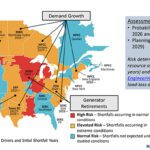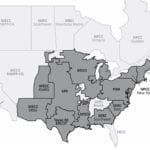A report released December 14 by the North American Electric Reliability Corp. (NERC) says power generation from natural gas-fired units and renewable sources such as solar and wind will provide enough electricity to offset the closures of U.S. coal-fired and nuclear power plants in the next decade.
The agency’s 10-year outlook, part of its 2017 Long-Term Reliability Assessment for the U.S. power grid, is at odds with a proposal from Department of Energy (DOE) head Rick Perry, who says grid resilience is at risk from the closure of nuclear and coal-fired plants. Perry has asked the Federal Energy Regulatory Commission (FERC) to adopt a plan for electricity pricing that would provide market incentives for coal and nuclear facilities, though the plan has many critics.
NERC’s assessment said “new resources, which are primarily natural gas and renewable generation, should collectively provide the bulk power system with the same level of voltage support, frequency response and other essential reliability services as conventional generators.” The report also said that growth in demand for electricity is at its “lowest rates on record,” which also helps offset the loss of some coal and nuclear generation.
NERC is designated by Congress to study the U.S. power grid; the agency is overseen by FERC. FERC commissioners likely will use the assessment report as they consider Perry’s market proposal over the next month. Perry granted the agency a 30-day extension to consider his proposed Grid Resiliency Pricing Rule; the original deadline to vote on the rule was December 11.
NERC’s director of Reliability Assessment and System Analysis, John Moura, on a conference call with reporters December 14, said the agency continues to look at reliability and resilience issues that could be caused by coal and nuclear plant closures. He did not talk about supplying justification for market incentives to ensure resilience and reliability.
“The accelerating move toward natural gas and renewables means the industry must adopt a more robust approach to planning the bulk power systems so that it continues to be reliably operated,” Moura said. In a statement, the agency said “Essential reliability services including voltage support and frequency response help maintain the stability of the bulk power system. The influx of generation from natural gas and renewables provides industry with a unique set of challenges and opportunities to maintain the system’s inertia and other essential reliability services.”
Key findings from the report include:
- Growth in electricity demand in North America is at its lowest rates on record.
- Reserve margins across North America are adequate through 2022.
- Planned retirements of conventional (coal-fired) generation in Texas and a canceled nuclear expansion in the Southeast (the V.C. Summer project in South Carolina) mean that reserve margins will drop below NERC-recommended levels beginning in 2018 and 2020, respectively.
- Coal and nuclear generation retirements have outpaced conventional (baseload) generation additions, which is being replaced by wind and solar.
- Retirement plans have been announced for 14 nuclear units, totaling 10.5 GW.
- Natural gas–fired capacity has increased to 442 GW from 280 GW in 2009, with an additional 44.6 GW planned over the next 10 years.
- Wind generation today accounts for more than 10% of total installed capacity in six areas, with 14.8 GW of NERC-wide additions projected during the next decade.
- A total of 37 GW of solar additions are projected by 2022.
The report also said that “all new resources should have the capability to support voltage and frequency,” and said FERC “should support new market rules that support the provision of essential reliability services,” and “should consider the reliability attributes of coal and nuclear generation to ensure that the resource mix continues to evolve in a manner that ensures the reliability and resilience of the bulk power system.”
“NERC will work with the industry on a comprehensive review of Reliability Standards to ensure compatibility with the changing resource mix and adequate levels of essential reliability services, including frequency response and increased system flexibility,” said Thomas Coleman, the agency’s director of Reliability Assessment.
—Darrell Proctor is a POWER associate editor (@DarrellProctor1, @POWERmagazine)










